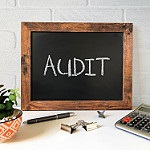Posted By Christopher Ciminera, CPA
 The Auditing Standards Board (ASB) has released a Final Balloted Draft of Statement on Auditing Standards, Forming an Opinion and Reporting on Financial Statements of Employee Benefit Plans Subject to ERISA (Final Balloted Draft).
The Auditing Standards Board (ASB) has released a Final Balloted Draft of Statement on Auditing Standards, Forming an Opinion and Reporting on Financial Statements of Employee Benefit Plans Subject to ERISA (Final Balloted Draft).
Per a note in the beginning of the Final Balloted Draft, the standard is expected to be finalized in the first half of 2019 after deliberations on other possible adjustments to the reporting rules in the Statement on Auditing Standards (SAS) are considered. The final standard will be effective for audits of financial statements for periods ending on or after December 15, 2020, with early adoption NOT permitted.
Background
To give a brief overview, in May 2015, the DOL released a report on audit quality.The findings of the review was a 39% deficiency rate of the audits in its sample. In addition to many education, certification, and awareness initiatives communicated in the report as possible remedies for improvement of qualified plan audits was a recommendation to repeal the limited-scope audit exemption. Key players in the DOL had expressed views that the disclaimed opinion, and some auditors’ misinterpretation of procedures to be performed in a limited-scope audit, were partially to blame for the continued 39% deficiency rate in the DOL’s Audit Quality Study. The Exposure Draft of this standard expressed that “The Chief Accountant of the Department of Labor (DOL) requested the ASB take a fresh look at the auditor reporting model for ERISA plan audits to provide better insight to the public regarding the scope of the responsibilities of management and the auditor, including when management imposes a limitation on the scope of the audit, as permitted by the DOL’s Rules and Regulations for Reporting and Disclosure under ERISA ERISA-permitted audit scope limitation).”
Limited Procedures and (Lack of) Auditor Opinions
One recommendation by the DOL was to amend ERISA to remove the limited-scope audit exemption. Luckily, that recommendation was not followed through. However, the DOL has worked with the AICPA and the ASB to update the standards and audit report requirements so that auditors provide an audit opinion on the financial statements that does not extend to the assets certified by a qualified institution, instead of a disclaimed opinion on the full financial statements based on the lack of procedures the auditor did not perform on certified investment information. Rather than being called a “limited-scope” audit, the audit will now be called an ERISA Section 103(a)(3)(C) audit, based on the applicable ERISA section.
Changes Applicable to the Full Scope and the ERISA Section 103(a)(3)(C) Audit Reports
For both audit reports, the following statements are added in the respective sections of the audit report:
- Introductory paragraph – that the plan is an employee benefit plan subject to ERISA.
- Management Responsibilities paragraph –
- that management is responsible for maintaining a current plan instrument (plan document, trust documents, plan amendment, as applicable), and
- that management is responsible for determining that the plan’s transactions are presented and disclosed in the financial statements in conformity with the plan’s provisions, including maintaining sufficient records with respect to each of the participants, to determine the benefits due or which may become due to such participants.
- Other Matter paragraph – that the auditor evaluated the supplemental schedules, including their form and content, to determine whether the schedules are presented in conformity with the DOL’s Rules and Regulations for Reporting and Disclosure under ERISA.
Changes Specific to the ERISA Section 103(a)(3)(C) Audit Report
ERISA Section 103(a)(3)(C) is unique to EBP audits and the fact that investment values and investment earnings are excluded from the audit scope is no longer considered a scope limitation that requires a disclaimer of opinion or other type of modified opinion. Instead, the audit report will provide a two-pronged opinion. First, the report will provide an opinion on whether the information that was subjected to audit procedures is presented fairly. Second, it will provide an opinion on whether the certified investment information on the financial statements agrees to or is derived from the certification.
Changes to the previous limited-scope audit required in the new ERISA Section 103(a)(3)(C) report include:
- In a new section in the audit report titled Nature of the ERISA Section 103(a)(3)(C) Audit:
- A statement that management has determined it permissible in the circumstances to elect to have audits of the plan performed in accordance with ERISA Section 103(a)(3)(C).
- A statement that the auditor, as permitted by ERISA Section 103(a)(3)(C), did not audit any statements or information related to assets held for investment of the plan by a bank or similar institution or insurance carrier that is regulated, supervised, and subject to periodic examination by a state or federal agency.
- In the Management Responsibility section of the audit report:
- A statement that management’s election of the ERISA Section 103(a)(3)(C) audit does not affect management’s responsibility for the financial statements.
- A statement that management is responsible for maintaining a current plan instrument, as noted in the previous section.
- In the Auditor’s Responsibility section of the audit report:
- A statement that the auditor obtained audit evidence for the amounts and disclosures in the financial statements based on the auditor’s judgment and assessment of risk of material misstatement. This language is currently only in the current full-scope audit reports.
- A statement that the auditor did not perform audit procedures to certified information, except for obtaining and reading the certification, comparing the certified investment information with the related information presented and disclosed in the financial statements, and reading the disclosures relating to the certified information.
- A statement that the objective of the ERISA Section 103(a)(3)(C) audit is not to express an opinion about whether the financial statements as a whole are presented fairly, in all material respects, in accordance with accounting principles generally accepted in the US.
- In the Other Matters section of the audit report covering supplemental schedules required by ERISA:
- A statement that the supplemental schedules are the responsibility of management and were derived from and relate directly to the underlying accounting and other records used to prepare the financial statements.
- A statement that the information included in the supplemental schedules, other than that agreed to or derived from the certified investment information, has been subjected to auditing procedures and certain additional procedures, including comparing and reconciling such information directly to the underlying accounting records used to prepare the financial statements.
- A statement that the auditor compared information included in the supplemental schedules to the certified information and evaluated whether the supplemental schedules, other than the information agreed to or derived from the certified information, are presented in conformity with the DOL’s Rules and Regulations for Reporting and Disclosure.
- A statement that the information in the supplemental schedules related to assets held by and certified by a qualified institution meets the requirements of ERISA Section 103(a)(3)(C).
The new language in the audit report will provide better clarity regarding management’s responsibility and the auditor’s responsibility, as well as an opinion on the financial statements in the case of ERISA Section 103(a)(3)(C) audits, which will hopefully alleviate some of the concerns and misunderstandings regarding the value and the extent of work that is required in an EBP-specific limited scope audit. In my next blog, I will talk about some other key takeaways I got from the new draft standard.
All blog posts are valid as of the date published
